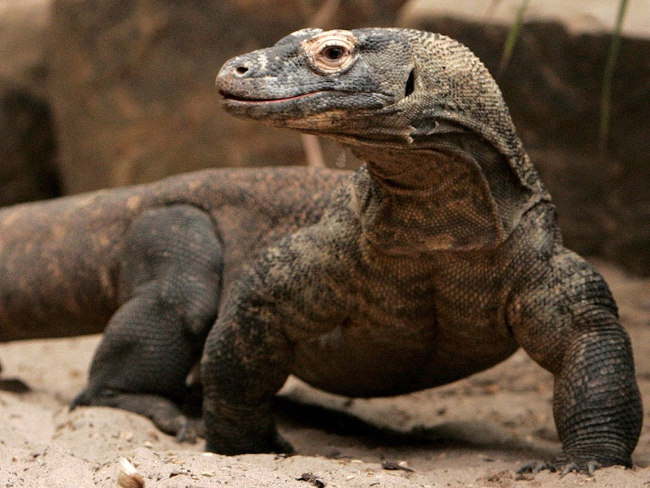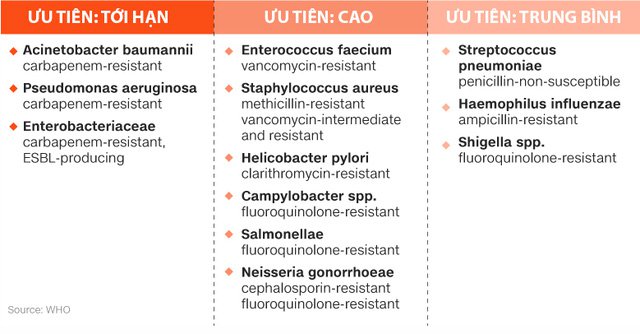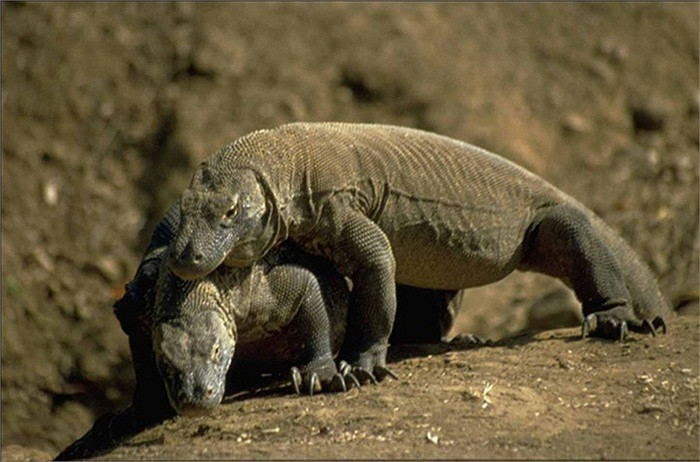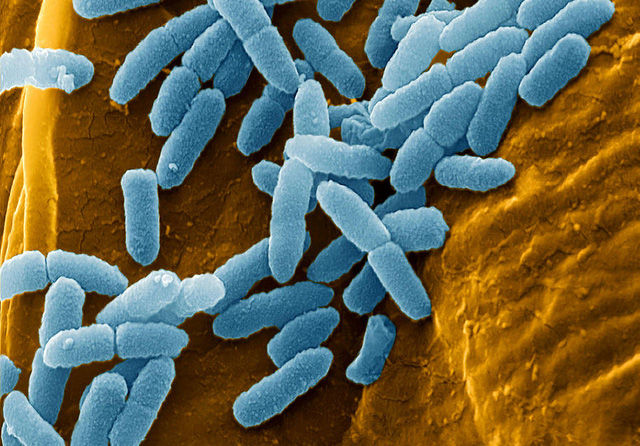Komodo dragon blood helps fight antibiotic resistant bacteria
Scientists from George Mason University in the United States recently discovered a new way to fight antibiotic-resistant bacteria through Komodo blood. Some compounds found in the blood of these giant lizards can be used to make new antibiotics.
It seems, real life dragon blood also contains many mysteries that are no less than in the legend.

They are able to resist two species of antibiotic-resistant bacteria in the top of the list recently published by the World Health Organization (WHO).

List of 12 most dangerous viruses published by WHO.
Komodo dragon is the largest lizard species on Earth that exists and is found only in some Indonesian islands. The maximum length of individual Komodo dragons can reach 3 meters.
Komodo dragons are carnivores, they hunt buffaloes, deer, goats and even the same kind. This dragon often attacks prey with fatal bites on the throat and waits for the victim to collapse. Because the venom and dozens of types of bacteria that cause damage in saliva the dragons that have been transmitted into the animal's blood through the bite will do the rest.
But why in the clashes with fellow humans, Komodo dragons are not infected?

In the animal world, not only Komodo dragons but also some other species carry peptides - amino acid sequences that are segments of proteins, have antibacterial properties (AntiMicrobial Peptides - AMP). These are weapons that help them fight natural infections.
When observing how the victims were killed from the Komodo dragon bite, the scientists suspected that their AMP must be extremely strong enough to protect themselves from fellow bites. If so, it will be a source of compounds that can help people develop new antibiotics.
Dr. Monique van Hoek and Barney Bishop collected fresh blood samples from Komodo dragons to search for the peptides in them. They discovered 48 types of AMP that have never been discovered before and they all have the potential to be used to prepare drugs.

Green pus bacillus
Dr. Hoek has exposed two extremely dangerous antibiotic-resistant bacteria to eight of the 48 newly discovered AMP types. Initial results were promising, 7 out of 8 AMP types inhibited the development of golden staphylococcus - Staphylococcus aureus and green pus bacillus - Pseudomonas aeruginosa. One of them only resisted the green pus bacillus.
Green pus bacilli and golden staph are the listed bacteria in the list of bacteria that humans need new antibiotics to treat the World Health Organization.
This new finding gives us more hope in the fight against antibiotic-resistant bacteria that causes the deaths of more than 700,000 people annually worldwide.
- New discovery: Dragonfly wings can kill bacteria without antibiotics
- 3 antibiotic resistant viruses have almost no drugs to treat
You should read it
- Komodo assassin dragon slayed a giant buffalo buffalo with a cup
- Artificial skin can support antibiotic resistance
- Multiple sclerosis drugs can combat antibiotic resistant bacteria
- Using AI to develop super strong antibiotics that can kill antibiotic-resistant bacteria
- Surfers who swallow seawater are more resistant to antibiotics
- NASA launched E. Coli into space to study antibiotic resistance of bacteria
- Warning: Detecting new bacteria resistant to antibiotics to treat kidney disease
- 3 antibiotic resistant viruses have almost no drugs to treat
May be interested
- Artificial skin can support antibiotic resistance
 now, scientists at queen's university belfast are developing a patch that they believe could slow the development of antibiotic-resistant bacteria.
now, scientists at queen's university belfast are developing a patch that they believe could slow the development of antibiotic-resistant bacteria. - 3 antibiotic resistant viruses have almost no drugs to treat
 recently, the world health organization - who has published a priority list of 12 most dangerous antibiotic resistant viruses in the world, becoming the biggest threat to human health. 3 of these viruses are almost no medicine to treat.
recently, the world health organization - who has published a priority list of 12 most dangerous antibiotic resistant viruses in the world, becoming the biggest threat to human health. 3 of these viruses are almost no medicine to treat. - Surfers who swallow seawater are more resistant to antibiotics
 a study in the uk found that frequent surfers tend to have higher antibiotic antibiotic resistance because their coliform e. coli is three times higher than non-surfers.
a study in the uk found that frequent surfers tend to have higher antibiotic antibiotic resistance because their coliform e. coli is three times higher than non-surfers. - Why does SpaceX send the deadly virus to the International Space Station?
 today, february 14, a sapcex falcon 9 rocket will be launched on the international space station (iss) carrying several laboratory boxes containing mrsa (methicillin-resistant staphylococcus aureus) - a bacterium dangerous antibiotic resistance.
today, february 14, a sapcex falcon 9 rocket will be launched on the international space station (iss) carrying several laboratory boxes containing mrsa (methicillin-resistant staphylococcus aureus) - a bacterium dangerous antibiotic resistance. - Dirty stethoscope can spread many types of antibiotic-resistant viruses
 if your doctor monitors you with an unhygienic stethoscope, chances are you may have an infection caused by the antibiotic-resistant virus, the researchers warned.
if your doctor monitors you with an unhygienic stethoscope, chances are you may have an infection caused by the antibiotic-resistant virus, the researchers warned. - Drug-resistant bacteria greatly affect people living in nursing homes
 a new study shows that 27% of nursing home residents are tested positive for gram-negative bacteria, also known as mdr-gnr (multidrug-resistant tb bacteria).
a new study shows that 27% of nursing home residents are tested positive for gram-negative bacteria, also known as mdr-gnr (multidrug-resistant tb bacteria). - NASA launched E. Coli into space to study antibiotic resistance of bacteria
 to study the antibiotic resistance of bacteria, scientists will take e. coli, a common pathogen bacteria related to urinary tract infections and food-borne diseases, to the iss dance station.
to study the antibiotic resistance of bacteria, scientists will take e. coli, a common pathogen bacteria related to urinary tract infections and food-borne diseases, to the iss dance station. - How to fight Ender Dragon in Minecraft
 how to fight ender dragon in minecraft. there is a way to win the minecraft game, which is conquering the dragon ender (ender dragon). and of course this is the most difficult challenge built in the game. your task is to go to the en
how to fight ender dragon in minecraft. there is a way to win the minecraft game, which is conquering the dragon ender (ender dragon). and of course this is the most difficult challenge built in the game. your task is to go to the en - How to use antibiotics effectively?
 antibiotics are drugs used to treat or prevent infection by inhibiting the growth or destruction of bacteria - a single-celled microorganism. here's how to use antibiotics effectively.
antibiotics are drugs used to treat or prevent infection by inhibiting the growth or destruction of bacteria - a single-celled microorganism. here's how to use antibiotics effectively. - What happens when you cut your hand?
 when you are mistakenly cut into your hand (broken hand), inflammation occurs, immune cells must work harder to fight bacteria from entering the wound.
when you are mistakenly cut into your hand (broken hand), inflammation occurs, immune cells must work harder to fight bacteria from entering the wound.










 Found a way to detect HIV-infected T cells that are 'dormant', opening up hope for root
Found a way to detect HIV-infected T cells that are 'dormant', opening up hope for root Patching heart defects with new biological materials
Patching heart defects with new biological materials Want to prevent liver cancer, just do 3 things well
Want to prevent liver cancer, just do 3 things well Unexpected story: Use supercomputers to help diagnose depression
Unexpected story: Use supercomputers to help diagnose depression Unexpected story: Science turns human kidney cells into small biological generators
Unexpected story: Science turns human kidney cells into small biological generators Find new ways to treat breast cancer
Find new ways to treat breast cancer